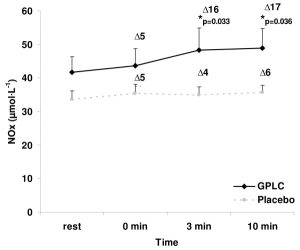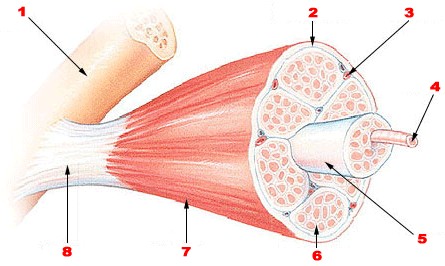Richard J. Bloomer, PhD
Department of Health and Sports Sciences
The University of Memphis
Dietary supplementation with the naturally occurring nutrient L-carnitine has been extensively studied as an aid to improve fatty acid metabolism and aerobic exercise capacity, to provide antioxidant benefits, and to enhance blood flow to active tissues (e.g., skeletal muscle and heart). While multiple forms of carnitine have been studied and are currently available, Propionyl-L-Carnitine (PLC) has been shown to best support healthy heart and skeletal muscle function. A patented and safe USP dietary form of PLC has been developed which is molecularly bonded to glycine, one of the precursor amino acids to carnitine biosynthesis. This form is known as Glycine Propionyl-LCarnitine (GPLC) or GlycoCarn®, and is one of the AminoCarnitines® branded and marketed by Sigma-Tau HealthScience. Since 2005, the health and performance effects of GlycoCarn® has been studied within human subjects, with a particular interest in the following.
Antioxidant Function: A well-described effect of PLC is the ability of this nutrient to reduce the potentially harmful effects of free radicals. Excess radical production can lead to a condition known as “oxidative stress” which is associated with damage to important molecules such as lipids, proteins, and DNA.
Fatty Acid Metabolism: Carnitine is critical for the transport of activated long chain fatty acids into the mitochondria of the cell (i.e., the energy producing component of the cell). In theory, increased fatty acid metabolism would result in the increased “burning” of fat as an energy source, leading to improvements in blood triglycerides, body fat, and energy levels. Vasodilatation (i.e., increased blood flow): An exciting finding in recent studies using PLC is improved blood flow. This appears mediated by an increase in the important signaling molecule known as nitric oxide (NO∙), which acts in blood vessel dilation (i.e., opening). Blood vessel dilation is important for maintaining normal blood flow, as well as for athletes seeking to enhance blood flow to aid oxygen and nutrient delivery to working skeletal muscles.
In our first study with GlycoCarn®, sedentary men and women were assigned to supervised aerobic exercise with or without GlycoCarn® treatment for a period of eight weeks. The main findings of benefit in subjects using GlycoCarn® included an increase in resting blood nitrate/nitrite (a surrogate marker of nitric oxide), as well as a drastic decrease in lipid peroxidation (a byproduct of free radical mediated damage), in comparison to subjects assigned to a placebo condition.
We also noted an average decrease in blood triglycerides from 11-22%, which occurred in a dose dependant manner (although not of statistical significance).
In a follow-up study in a group of resistance trained men, we noted that blood nitrate/nitrite was higher at rest in subjects when consuming GlycoCarn® compared to placebo and increased to a greater extent following exposure to an exercise stimulus. To our knowledge, GlycoCarn® is the only dietary supplement to date shown to yield an increase in blood nitrate/nitrite in human subjects.
Interested individuals may secure a full text copy of these studies online (www.pubmed.gov) or by contacting me directly at rbloomer@memphis.edu.
Considering the available evidence, it can be stated that GlycoCarn® may 1) provide antioxidant function to decrease the potentially harmful effects of free radicals, 2) enhance nitric oxide production which may allow for improved blood flow and 3) improve blood triglyceride values which may be related to enhanced fatty acid metabolism.
Hence, GlycoCarn® may be considered as a multi-component dietary supplement. In these regards, Life Extension’s Optimized Carnitine® and Peak ATP® with GlycoCarn®, both of which contain GlycoCarn®, may be considered as one component of a complete supplementation regimen in otherwise healthy individuals. Of course, as with all dietary supplements, individual response will vary. That is, some may experience extraordinary benefits while others note little benefit. Experimentation on the part of the individual, coupled with the approval and supervision by a qualified health care professional is always necessary.

Figure 1. Plasma nitrate/nitrite before and after an ischemia-reperfusion protocol in 15 resistance trained
men supplemented with GPLC and placebo in a cross-over design.
Note: Condition main effect (p=0.0008); No time main effect (p=0.7099) or interaction effect (p=0.8809);
paired time contrasts at 3 (p=0.033) and 10 (p=0.036) minutes post protocol; rest (p=0.189) and 0 (p=0.187)
minutes post protocol; % change from rest presented for each time post protocol. Values are mean ± SEM.
Biography
Richard J. Bloomer holds a PhD in Exercise Physiology and is currently
an Assistant Professor within the Department of Health and Sport
Sciences at The University of Memphis. He held prior positions at Duke
University Medical Center and Wake Forest University. His research
focus is centered on oxidative stress and antioxidant therapy.






